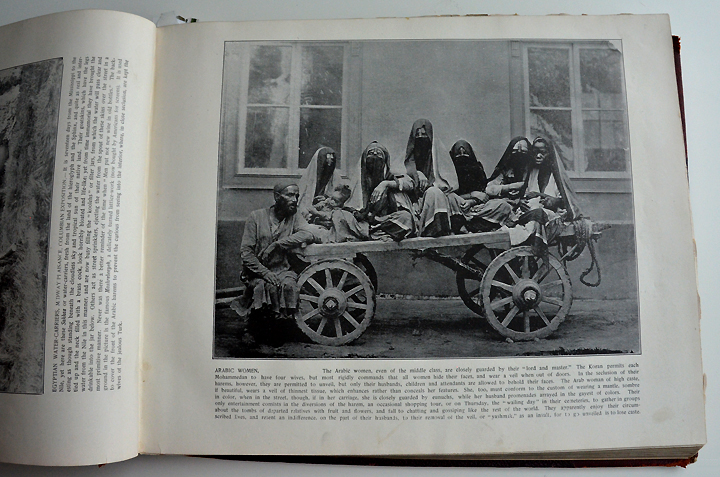Around the World with a Camera (circa 1894) - Part II
TOBOGGAN SLIDE, MONTREAL, CANADA In Canada the ice king reigns supreme. The clear and frosty air and sparking wintry days that last through many months of the year make Canada the home of winter sport. Tobogganing has become the favourite winter pastime. The toboggan was originally a small sledge used by the Indians of Canada for transporting their belongings. Adopted by the Pale faces it became somewhat more elaborate and luxurious, though still an Indian sledge. Montreal is the chief centre for tobogganing, but recently much progress has been made in the United States. This most exhilarating sport is not without its spice of danger and resembles the riding of a whirlwind.
THE GARDEN OF GETHESMANE, PASSION PLAY, OBERAMMERGAU
The interest in this little village in the heart of the Tyrolese Alps, all centers about the Passion Play that is performed here once in ten years, in commemoration of a vow made by terrified villagers in 1634, to enact the sufferings and death of Christ once in ten years in the event of their escaping the plague which then prevailed. It is the only survival of the miracle plays and mystery plays of the middle ages. Nearly five hundred persons join in the pageant and present a most impressive and never to be forgotten spectacle.
CRYPT OF CAPUCHIN CHURCH, ROME Underneath the Capuchin Church in this celebrates crypt, the floor of which, like that in the Campo Santo in Pisa, is composed of consecrated earth brought from Jerusalem. It is considered a precious privilege by the brotherhood to sleep in holy ground; and in order that each good friar may in turn enjoy the luxury of a consecrated bed, they have been accustomed for many years, when one of their number dies, to take the longest buried skeleton out of the oldest grave, and lay the new slumberer there instead. These skeletons are used for the decoration of this unique cemetery; hooded monks are stood in niches, their names attached to the like labeled flowers at a show.
THE KAGO, OR TRAVELING CHAIR, JAPAN Americans accustomed to luxurious palace cars and comfortable carriages cannot easily accustom themselves to the primitive mode of travel in Japan. The “kago” is the time-honored means of transportation, but its use is now largely restricted to the nobility and the ladies. The coolies that are employed for this purpose are of the lowest class of peasants in Japan, usually farm laborers who have accepted their arduous task for the added compensation. They posses remarkable powers of endurance, being able to carry a heavy person during a whole day without apparent fatigue. A covering is placed over the whole when it is needed to protect the fair occupant from the storm. The cramped position assumed must be very tiresome after a few hours.
APPIAN WAY, ROME Of all the great thoroughfares of the world the Appian Way is, perhaps, the most historic and best known; for it was build three centuries before the birth of our Saviour, and was old when St. Paul journeyed over it on his way to Rome. The Romans were good road builders and this military highway is broad and straight, paved with volcanic stone, and lined with the shattered fragments of Mausoleums and tombs of those who were once geat, noble and rich, but whole wealth, fame and history have perished like the crumbling monuments they erected. How dreary seems the Campagna beyond, contrasted with the triumphs once enacted here!
ARABIC WOMEN The Arabic women, even of the middle class, are closely guarded by their “lord and master.” The Koran permits each Mohammedan to have four wives, but most rigidly commands that all women hide their faces, and wear a veil when out of doors. The Arab woman of high caste, too, must conform to the customs of wearing a mantle, somber in color, when in the street, though, if in her carriage, she is closely guarded by eunuchs, while her husband promenades arrayed in the gayest of colors. They apparently enjoy their circumscribed lives, and resent an indifference, on the part of their husbands, to their removal of the veil, or “yashmak,” as an insult, for to go unveiled is to lose caste.
GLENGARIFF HARBOR, IRELAND Language utterly fails to convey even a limited idea of the exceeding beauty of Glengariff—“the rough glen”—which attracts almost as many pilgrims as the Giant’s Causeway. Surely nothing in Ireland is equal to it, or can be brought to comparison with it as it lies there in the retirement of sublime seclusion in a deep Alpine valley, enclosed by precipitous hills that surround it like the dark frame of a picture. The artist can not do this place justice; and the pen must be laid aside in despair. Our memories, indeed, recall every portion of the magic spot, but only to convince us how weak and inefficient must be our efforts to describe it.
If you missed it, see Part I, for an introduction to this incredible book and more images. Plus, some other gems from the Lakefield bookstore.














